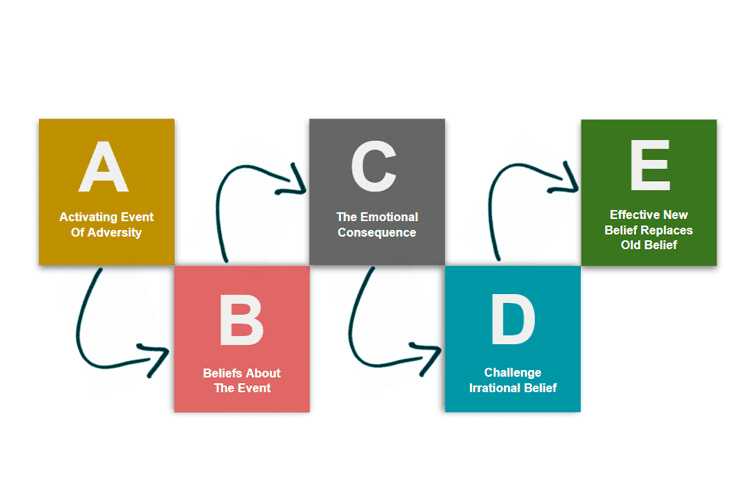Introduction
Our mental health significantly impacts how we perceive and react to our rapidly changing and fast-paced world. The transformative “ABCDE” method provides an organized and efficient way to maneuver through the complex world of thoughts and beliefs. Knowing and using this technique can revolutionize personal development in a society that values resilience and adaptability as virtues.
The “Abcde” method is a path to self-discovery and constructive change, not just a series of letters. The process’s five essential steps—awareness, belief, challenge, decision, and execution—are represented by each letter.
Is your mental health in need of urgent attention?
The ABCDE method offers immediate strategies to help you regain control and improve your well-being.
Gaining control is as easy as ABCDE
The ABCDE method was created by Albert Ellis, the creator of Rational Emotive Behavior Therapy (REBT), to give individuals a precise framework for freshly examining these internal processes.
As you begin to tackle the situation, you may find a sense of control returning. Methodically dissecting events into manageable steps offers a strategy to eliminate the apparent ‘mystery’ surrounding your responses. By shining the bright light of mindful awareness upon your internal processes, you will discover they are not as mysterious or scary as once thought.
A- Activating Event in ABCDE Model

Closely observing certain events that trigger emotional responses in you is the first and most important step to getting a command over your emotions and thoughts.
1. Document the event(s): Name the particular incident or situation that made a shift in perspective necessary or desirable. This might be a result of a professional or personal experience that has made gaps in your present perspective apparent.
2. Examining the Effect on Mentality: Consider how the activating event has shaped your ideas, convictions, and general way of thinking. Think about whether the opportunities or challenges that the activating event presents are sufficiently addressed by your current mindset.
3. Taking Up Limiting Beliefs: Consider whether any limiting beliefs related to the activating event are impeding your growth or overall well-being. Examine opposing viewpoints that support constructive development and refute these assumptions.
B- Beliefs in ABCDE Model

The “ABCDE” method’s next step is to explore beliefs after awareness has been established. The fundamental convictions that influence our viewpoints, attitudes, and behaviors are known as beliefs. This step entails analyzing these beliefs and, if required, rearranging them to better fit a growth-oriented and optimistic outlook.
1. Analyzing Held Beliefs: Determine the core beliefs guiding your thoughts and behavior. Think about whether these beliefs help or hinder your ability to achieve your personal and professional objectives.
2. Changing Negative Thoughts to Positive Thoughts: Find any limiting or negative beliefs that might be preventing you from moving forward. Examine alternate, more empowering viewpoints and raise valid questions to counter these assumptions.
3. Developing an Attitude of Growth: Accept the idea of a growth mindset, in which obstacles are seen as chances for development and learning. Encourage attitudes that place a strong emphasis on flexibility, resilience, and the potential for personal growth.
4. Matching Beliefs to Objectives: Make sure your values align with the objectives you have set for yourself. Adjust your beliefs as needed to build a mental model that serves your goals.
A more constructive and upbeat mindset can be established by addressing and reshaping beliefs. A deliberate effort to question and alter beliefs that might be limiting your potential is required for this process. As you move past the “Belief” stage, you create the conditions for a way of thinking that supports achievement, personal development, and general well-being.
C- Consequences in ABCDE Model

Knowing the effects of your thoughts and deeds is a crucial phase in the ABCDE process. This entails assessing the effects of your attitude and actions, both good and bad, and using this knowledge to guide your decision-making.
1. Thinking Back on Previous Outcomes: Think about how your mindset affected the decisions you made in the past. Determine the trends of favorable or unfavorable outcomes associated with particular attitudes and actions.
2. Considering Potential Aftereffects: Imagine the possible consequences of keeping your present perspective. Determine whether your actions and beliefs are in line with your long-term objectives and general well-being.
3. Changing One’s Perspective to Aim for Benefits: If unfavorable effects are found, consider how changing your perspective can result in better outcomes. Ensure that your actions and beliefs are in line with what will lead to success and personal development.
4. Taking Lessons from Past Events: Consider both favorable and unfavorable outcomes as teaching moments. Make use of the knowledge you have gained to hone your mindset and make it more favorable to reaching your goals.
The ABCDE method gains a contemplative component when you include the idea of consequences in it. This step invites you to reflect on how your mindset affects the outcomes you encounter in different areas of your life. It supports the notion that deliberate mental adjustments combined with mindful awareness can produce more favorable outcomes and, in the end, help people live more successful and fulfilling lives.
D- Disputing in ABCDE Model

The emphasis at this point is on actively refuting or opposing unfavorable ideas and viewpoints that impede personal development. It entails having a constructive internal conversation to challenge the veracity of limiting beliefs and cultivate an optimistic outlook.
1. Recognizing Adverse Thoughts: Identify the ideas that feed a pessimistic or constrictive mindset. Identify negative or self-critical inner monologue.
2. Defying Pessimistic Ideas: Challenge the veracity of negative thoughts to actively refute them. Seek information that defies these unfavorable assumptions.
3. Negative Thoughts Replaced: Negative thoughts should be swapped out for more practical and upbeat ones. To combat negativity, practice self-talk or affirmations.
4. Creating a Positive Internal Conversation: Make it a habit to think positively and speak to yourself. Build self-empowering beliefs that support a growth mindset by putting your attention there.
The “Dispute” stage promotes a mental environment that is favorable to success and personal growth by actively challenging and disputing negative ideas and beliefs. People can progressively change their mindset to one that is more upbeat, resilient, and goal-aligned by having this internal conversation.
E- Effects in ABCDE Model

In the last stage of using the ABCDE, we start concluding and entails considering the overall results and impact of the mindset transformation process. It centers on evaluating the beneficial outcomes that have been attained by putting new beliefs into practice, confronting unfavorable ideas, and encouraging a growth-oriented mindset.
1. Focusing on Personal Development: Consider how your perspective has changed as a result of the transformation. Decide on particular areas for your personal development.
2. Evaluation of Behavioral Shifts: Think about the behavioral adjustments brought about by a mental change. Determine which positive behaviors and habits have taken hold.
3. Observing Emotional Health: Examine how resilience and emotional well-being have changed. Think about how your general level of happiness and satisfaction has changed as a result of the altered mindset.
4. Analyzing Interpersonal Connections: Evaluate how the shift in perspective has affected your relationships with other people. Think about enhancing cooperation, empathy, and communication.
5. Honoring Successes: Celebrate and recognize particular victories and turning points in the process of changing your mindset. Acknowledge the beneficial impacts on different facets of your existence.
During the “Effects” stage, people can recognize the material and immaterial advantages that come from deliberately changing their perspective. Through the evaluation of favorable alterations in ideas, actions, feelings, and interpersonal connections, people acquire a more profound comprehension of the immense influence that a changed mindset can exert on their general welfare and achievement.
Tired of fighting addiction and mental health struggles?
Ignoring both deepens the struggle. Our holistic approach—detox, therapy, and medication-assisted treatment—can help you heal. Take the first step today.
FAQs- ABCDE Model
Que: What is the purpose of the ABCDE model?
Ans: Compared to simpler, solution-focused coaching models, rational-emotional coaching models—such as the ABCDE model—are more intricate and challenging to apply successfully. These kinds of models aim to dispel someone’s false or harmful beliefs and offer fresh, constructive perspectives in their stead. These kinds of coaching models can assist in altering an individual’s mindset and way of being, whereas solution-focused coaching assists people in reaching particular objectives.
Que: Who created the ABCDE model?
Ans: The ABCDE model was created by Albert Ellis in the field of rational-emotive behavior therapy. It guides individuals through a contemplative process to determine whether they should or should not alter the way they think about and respond to certain emotions.
Que: What is a real-life example of the ABCDE model?
Ans: Taking an example of a student experiencing anxiety after not performing in an exam and thinking, “If I fail it this time, I’m sure I’ll fail next time”.
Their stomach turns and they get shaky as the dread sets in. Breaking this down in ABCDE model would look like follows”
Receiving a failing grade is the activating event (A). It’s believed (B) that they will fall short once more. The physical symptoms they are experiencing now are the consequence (C). In this instance, the student’s illogical belief has unsettling results. We dispute (D) when we have doubts about our beliefs. This could appear as recognizing the illogical or unreasonable belief and substituting more beneficial, logical, or constructive ideas for ineffective ones. The ultimate stage is effective behavior (E), which is what therapy attempts to accomplish.
Conclusion
Within the context of personal development, the “Abcde” method is a potent tool for positively altering your mindset. This method provides a structured approach to cultivating a growth-oriented and positive outlook on life through the stages of Activating Events, Beliefs, Consequences, Disputes, and Effects.
It’s evident as we wrap up this exploration’s chapters that developing self-awareness is the first step toward changing your mind. Knowing your existing beliefs and cognitive processes is the first step toward making deliberate changes in your life. It is possible to develop a mindset that sees opportunities in challenges and builds resilience in the face of adversity by engaging in the process of challenging and disputing limiting beliefs.
As you set out on your path of metamorphosis, keep in mind that change is an ongoing process. Appreciate the little things in life, learn from your mistakes, and let the “Abcde” approach guide you through the changing terrain of your mind.
You can start your healing journey with Avisa Recovery where we provide individualized treatment, advanced medical care and a strong community to support you at all times. From mental health programs and holistic therapies to treating patients with substance use disorders, our team of experts ensures a long-term success in your recovery.











